Preamble
Des Linden (winner of the 2018 Boston Marathon) famously said that to succeed you need to, “keep showing up.”
There’s no gentle way to say this, but I’ve shown up a lot in the last year and, unfortunately, haven’t had much to show for it. Last fall (2018), I was injured most of the season and still showed up at CIM in December to drop out after only 10 miles. In the spring of 2019, I put all my eggs into the Project Carbon X basket and (despite some promising races and training leading up to that) ended up shooting for the moon and missing the mark spectacularly and dropping out again. I bounced back and ran Vermont City Marathon a few weeks later, but only managed to finish 3rd in a race I’d never lost in three previous starts.
Then, this fall (2019): I had the best summer of training of my life, showed up at 50K Worlds ready to win and got food poisoning the night before and basically didn’t start (I attempted to race but only ran the first 7km). With all that fitness and no chance to test it, I showed up at the Berlin Marathon four weeks later, hoping to run under 2h15. Instead, I struggled after 25km and finished in an extremely disappointing 2h22.
Most people would have called it a season at that point. Shut things down and try again in a few months. The body can only keep peaking, racing, and recovering so many times. And the haters probably would have just called it a career: time to hang up the shoes, bub.
But when fellow New England ultra-runner Patrick Carron recommended the USA 50 Mile Championships, being held on Oct 27, I decided to show up one more time.
In some ways, I felt no pressure going into this race. There were seemingly infinite number of reasons it wouldn’t go well: it would be my longest run ever, I was hanging onto the coat-tails of my summer fitness which I’d been stretching out over two months now, the race was held on an extremely hilly course and I’d been training for two pancake flat courses this fall (Worlds and Berlin), oh and did I mention that I’d long-ago committed to a big media event in Bangkok, Thailand from October 20-23 (i.e. Sunday-Wednesday of race week)?
Yet, I simultaneously felt enormous pressure, both internally and externally. I hadn’t raced well on a big stage since the spring of 2018 when I ran 2h46 for 50K (the second fastest time ever by an American) and then won Vermont City Marathon in 2h17 just 5 weeks later. Both for myself and for my career as an athlete, I really wanted, needed, to have a good race this fall. And I’d already decided that this was my last shot. No more dragging out the season after this one.
It was do or die.
Race day
It’s dark and raining when my alarm goes off just before 04:00. Luckily, my body has been on a fairly early sleep-cycle after my whirlwind trip to Asia early this week, and the morning feels not too dissimilar from any other and I’m up, eating a granola bar, and having coffee within a few minutes.
By 05:45, my parents are up and I’ve got my kit on, taken the classic flat-bruce photo (gotta keep things light on race morning), and have my back-pack full of food, liquid, and extra clothes ready.
One of the many differences in this race from anything I’ve ever done before is the logistical complexity involved in its support. My parents have been kind enough to come down to State College, PA and help keep me going which — unlike the many races where they’ve seen me run in the past — is a much more hands-on process for them this time. They’ll be responsible for driving our bright-blue hyundai accent from aid station to aid station where they’ll be able to hand off fluids, gels, or anything else I might need from this back pack of goodies (a changes of clothes or shoes, Vaseline, ibuprofen, etc.)
As we arrive at the start area, the rain continues coming down and night still completely shrouds us in darkness with no moon and few streetlights. I sit in the car, nervously making conversation with my parents, with no desire to leave the warm and dry confines of the front seat. At some point, I jog about 100m down to the port-a-potties and back. It’s thankfully not particularly cold (about 50F and a bit windy) and the rain seems to be lightening. I check the weather and see that one more strong band of rain is coming over the next couple hours but the skies should clear by about 10am.
Finally, around 06:50, I can’t stall anymore. I wear my very light HOKA rain-coat over a t-shirt and my running-vest (which holds a few backup gels and my bottle of maurten), compression shorts, and a pair of light gloves. I’m a bit chilly standing around in this at the start, which I figure is perfect.
I do no warmup, but some very light dynamic stretching and drills. I see Devon Yanko from the 50K team (who I didn’t know was going to be here) and say hi and look around for other fast looking dudes. Then, we’re lined up and we’re off. A nice romp through the forest!
I get off the line quickly to stay out of trouble and then settle in behind two other runners — Cole Crosby and David Kilgore. The pace feels extremely slow, but I’m happy to settle in and turn my brain off. It’s still extremely dark but luckily this first stretch of the race is one of the few paved sections of the route, so footing isn’t much of an issue.
The race course is unlike any I’ve ever run. There’s barely a flat meter on the entire circuit but rather it climbs and descends, sometimes steeply, but always relentlessly. This starts immediately as the course climbs consistently for the first 8km to the first of what I’ve outlined as 5 distinct peaks.
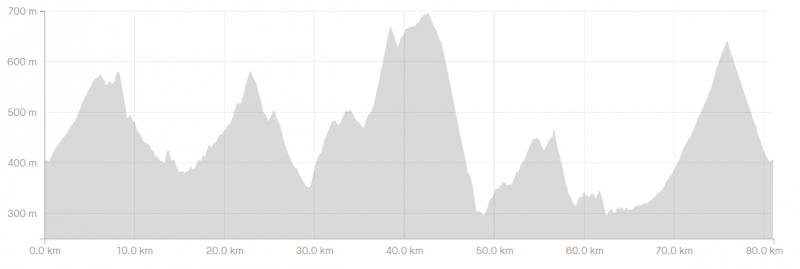
The elevation profile of the US 50 Mile Championships at Tussey Mountainback 50M (Note scale is meters/kilometers)
Compartmentalizing big races (and workouts) has always been a strength of mine and has consistently helped me, especially mentally, in these longer efforts. This race — being my longest ever — is no exception. On my arm, I’ve written the kilometer markers for the bottoms and tops of each of the 5 major climbs: 0, 8, 15, 23, 29, 42, 48, 56, 63, 76, 80. This breaks the race up well in my mind into a series of uphill and downhill segments and — honestly — I really never think about running 50 miles or have XX miles to go, but rather only think about which section I’m in, how long until the start of the next uphill/downhill stretch.
It’s also worth taking a second here to talk about my overall race strategy and plan. I really, really want to win this race. And I know that the best way for me to do that is to run smart and run patiently, even if that means running a slower overall time than I might be capable of. So, unlike so many races I’ve run in the last few years, from Project Carbon X to Berlin Marathon, I’m not concerned with the pace at the start of the race. I’m happy for it to feel slow, as I know my best chance of winning will be to run conservatively through the first 50-75% of the race and then feel like I have plenty of energy left for the remainder.
I’ve scouted out the course and picked out the earliest point that I’d want to try to begin pushing: 56km (about 35 miles) marks the top of the penultimate big climb. I’ve driven from this point to the finish, so I know what to expect and while it still contains a lot of challenging terrain, there at least won’t be any surprises.
But back to the beginning. I’m tucked in behind David and Cole and running up the first climb. It’s dark and I’m a bit cold as the rain has begun to pick up but I’m trying to convince myself that I’m not even running yet; it’s just a half-asleep warm-up. As dawn breaks, the rain picks up until we’re running through a serious rain storm. The road has turned to gravel which is a bit wet and muddy and puddly at times but the pace is so slow that it’s no bother. We pass the first aid station at the top of the climb and begin a nice long descent.
I’m really holding back at this point and actually stop briefly both because I really need to pee and also it gives me the opportunity to open up my legs a bit to run down the hill and catch up with the others, which running feels fantastic. I think it’s somewhere on this long downhill that we drop David and now it’s just Cole and me running together.
The rain is extremely heavy as we come into the second aid station around 15km. It’s seriously like being in a shower and as we start the second climb, my shoes (and all my clothes) are soaking wet and everything feels heavy.
This climb feels awful. It’s this weird balance of expectations vs. reality, where I’m expecting it to still feel really easy but we’re running a tiny bit quicker (though still fairly slowly) and maybe my heavy shoes make it feel worse; but it’s the first time that I really think “what have I gotten myself into? I already feel kind of bad and there’s a LOT of running left!” But, I’ve done enough long runs and workouts that I let those thoughts slide off my brain — water off a duck’s back — and keep on chugging.
The top of the climb feels great and the rain has lessened and it’s now fully day-time and, as I’d hoped, things are starting to feel better. I appear to be holding back much more on the downhill stretches than Cole, so this piece from 23-29 really feels like a jog which is great as 29-42km marks the longest and steepest climb on the course.
As we enter this section, I secretly hope that Cole doesn’t want to push too hard going up this long climb and I’m surprised to actually see him a few steps behind me as we come out of the aid station and begin the climb. I’d made it very clear I was keying off of him — I’d waited for him for a few seconds at the 15km station — and, per my own plan, wanted to be as conservative and conserve as much energy for the finish in these early kilometers as possible. So, I slow down and let him catch up and continue at his pace up the long climb.
We reach a false summit around 34km and run downhill about 1km before the remainder of the climb and I can tell that Cole is struggling, our slowing. And so, on the second half of this climb, I find myself establishing more and more of a gap, despite running what still feels like a very relaxed pace. I’m violating my own rule of not leading before 56km, but I also still feel comfortable keeping myself under control and running at a consistent but easy pace by myself.
By the time I reach the top of the hill and pass the halfway point (right around 3h00 at 25 miles/40km+ or ~7’12/M or 4’28/km average), the gap has grown to maybe 30-45 seconds and I ask my parents to keep me updated on what happens as the race goes on.
Now in the second half of the race, I’m feeling great. We have a long, steep downhill but I’m still holding back to run as smooth and relaxed as possible, waiting until that 56km point to really let myself go. Wait.
The day has improved as well; the rain has stopped and the temperature has risen. I’d ditched my rain coat and gloves around 35km and now feel great just running in a t-shirt. Aside: It’s worth noting that I drank nothing in the first 2h30 of the race, partly because my bottle was tucked in the back of my vest, which was under my rain coat, and partly because I just wasn’t thirsty at all. Now, 3h00+ into the race, I ask my parents to hand me one of the nuun bottles I’ve stashed in their car at the next aid station. Fueling hasn’t felt like a problem (I’ve been taking in 100 calories every 20’ via gels and oreos without issue), but I want to make sure I’m getting some electrolytes over the rest of the race as it begins to warm up and I begin to sweat more.
At 48km, 30 miles, I’m still feeling great and am starting to get excited as I know this is the last climb before my self-established “go point.” I keep the effort the same heading up this rolling stretch, including a few very steep pieces, until I finally recognize the last extremely steep climb up to where I’d driven out the day before. This is a huge mental boost. I’ve seen all of this before. I know what’s coming.
And so, I finally let myself go a bit on the short but steep downhill and then just try to keep that turnover and effort going as the course rolls down to the Whipple Dam aid station at 63km, the start of the last monster hill, the longest unbroken climb and the most altitude gain of any of the five significant summits on the course; it tops out around 76km, 47 miles.
I pass my folks at 39 miles and they tell me that Cole was 5+ minutes behind me at the last aid station. I know that the only way I’m going to lose this race is if I fall apart or push too hard too early, so I begin the long climb uphill with this defensive attitude, this caution, in the back of my mind. I know there’s a quick downhill 5km to the finish and my time will likely still be under the World Championship standard of 5h50, so there’s no reason to push excessively now.
These 7 miles feel extremely long. Unlike most of the previous climbs, which were broken up by gentle rolling or a false summit, this climb is unrelenting and continuously up. 40 miles (64km) is, incidentally, also the farthest I’ve ever run. This is new territory.
My body is feeling the fatigue of 4+ hours of running. My feet and ankles hurt more than anything else. I’ve got a small rock in my right shoe but am too stubborn to stop and take it out; it feels sharp and every few steps ends up directly under my big toe and feels like I’m stepping on a thumbtack. Still, I trudge upwards.
My mind is really not doing much at this point except for looking around the corner and trying to find the next little blue mile-marker sign. My last easy run the day before had started about 2.5km (1.5M) below the top of this hill, so I’m hit with a wave of adrenaline when I finally reach that point. The end really feels in reach. These are the longest kilometers of the day (and they were some of the steepest, with about 60m of gain each), but I finally see clear sky through the trees and come around a corner and see my parents at the top of the hill.
I ditch my vest for this last stretch and grab just a small bottle of nuun which I sip on the way down (and even pour on my head a bit as it’s now close to 65F and the sun has come out). I try to push on this stretch but don’t have turnover in my legs that I expect. I guess 47 miles of running takes its toll, even if it’s not that fast!
Still, after recovering from the long climb, I feel infinitely better and force myself to work for these last few minutes, the mile markers coming quicker now: 48, 49. Finally, I hit the bottom of the hill and the pavement which marks the beginning of the loop where we’d turned left over 5 hours earlier in the dark and rain.
Now, I turn back towards the start, finally retracing my steps, and make my way up the last tiny incline on the course, around the last turn, the starting banner in view. I see my mom standing in the middle of the road.
“Where’s the finish?!” I shout, laughing, as I’m expecting it to be the same as the start line, but see a left turn down onto a gravel path and the official finish tape and clock and push down and through, the clock ticking at 5:43:xx, and break the tape as National Champion.
Afterward.
When I flew down to PA on Friday for this race, I wrote out a list of goals for the race (as I do before most big races):
Priority #1. Finish
D. DNF
C. Finish off podium
B. Finish on podium
A-. Finish, win
A. Finish, win, CR
A+. Finish, win, worlds standard
(Add one level for negative split)
By my own standards, this was an A++ race.
This was that good race for which I’d been waiting. Distance running is a hard sport not just because it’s painful and time-consuming but because we’re judged on the handful of races we run each year, not the thousands of hours of training we put in beyond those select competitions. Sometimes those races correlate with, are a reflection of, those thousands of hours of training; sometimes, they’re not. Despite feeling like I’ve had some fantastic blocks this year, the truth was that I didn’t have the races to show for it.
This was the first race I’ve run in almost 18 months that felt like it lined up with my fitness and expectations. It was my first “A” race in too long.
There are a lot of questions now looking ahead. Will I continue to run these longer races? Will I give up entirely on the marathon and anything shorter? Will I start racing trails? Will I run Comrades in 2020?
These questions — and many more — I’ve heard from others and have been bouncing around in my head for the last 24 hours since finishing this race. The short answer, to all of them, is: I don’t know.
All I know is that I’m glad I kept showing up. I’m glad I can take a break now and have the time to think about what’s next. Yes, there is much more to come. To figure out exactly what that looks like, well — stay with us.
Thank you
Lastly, I want to give thanks to a few specific folks who helped make not only this race happen but also the many months of training leading up to it possible.
First, this race wouldn’t have happened without the support of my parents who came to State College, PA and drove our tiny rental car along steep gravel roads for 50 miles in the cold rain and handed me whatever I shouted that I needed as I ran by; thank you for your support this weekend and for the last 29 years of my life.
Thanks to those who encouraged me to keep showing up this fall, especially my long-time friend and coach Jon Waldron, my agent Josh Cox, and other encouraging friends like Matt Weickert, Susan Dunn, Lin Gentling, Patrick Reagan, and Patrick Carron.
Thanks as well to my sponsors HOKA ONE ONE, Strive Trips, nuun, and Maurten, all of whom contributed greatly to my success on Sunday.
Of course, I owe tremendous thanks to my own little family — my partner Mariana and my cat Richard Parker, who inspire me and love me and keep me going every day.
And lastly, thanks to anyone out there who has sent a message of support, shared a run, or simply said hello on a starting line. The World is full of amazing people and I’m so grateful to have connected with so many of you through our sport.

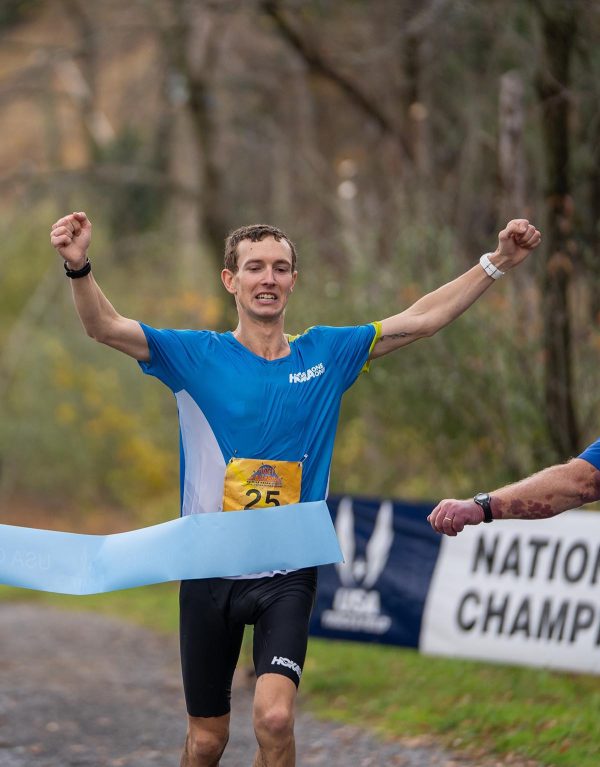
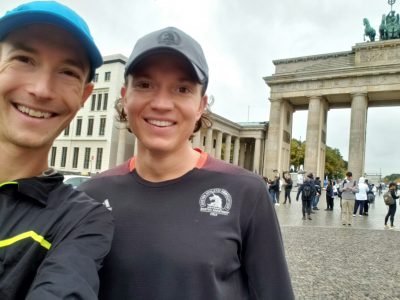
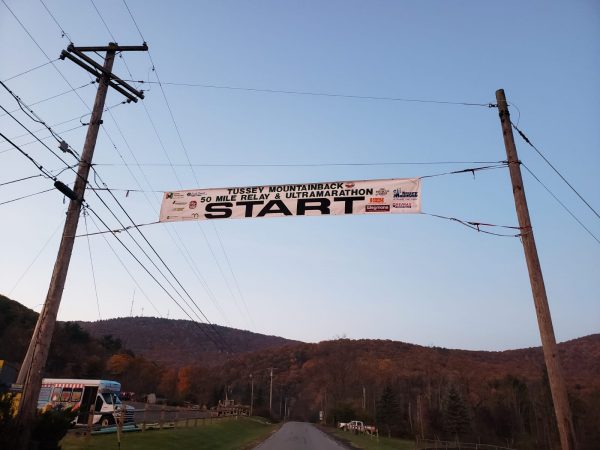
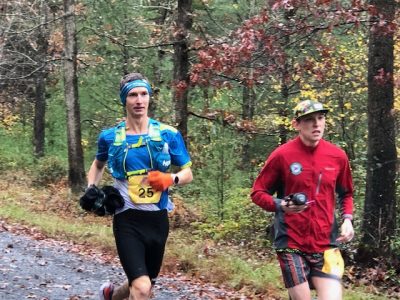
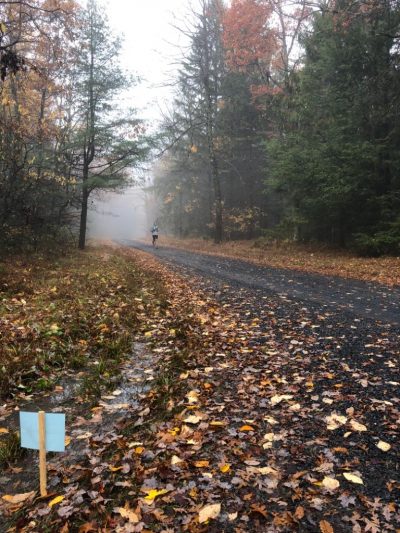
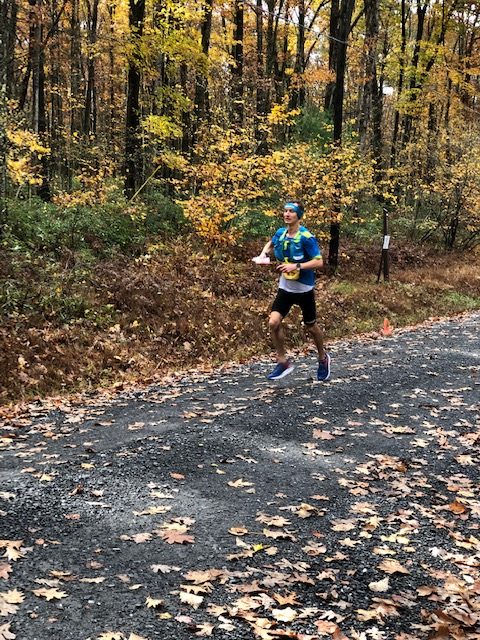
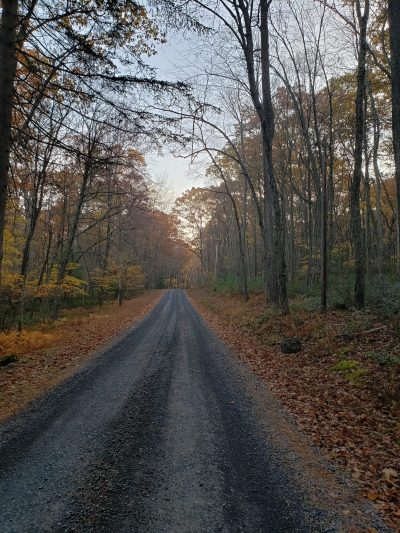
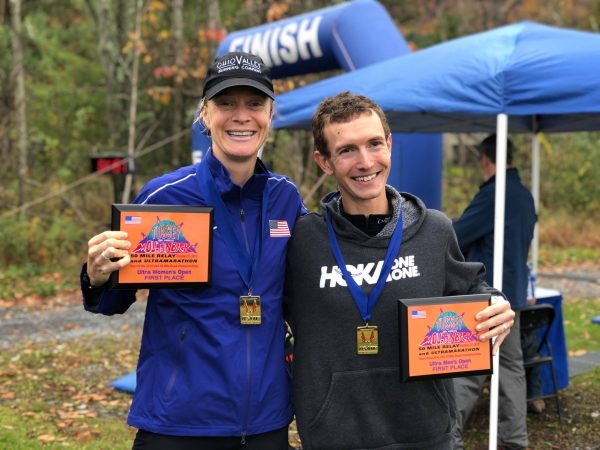
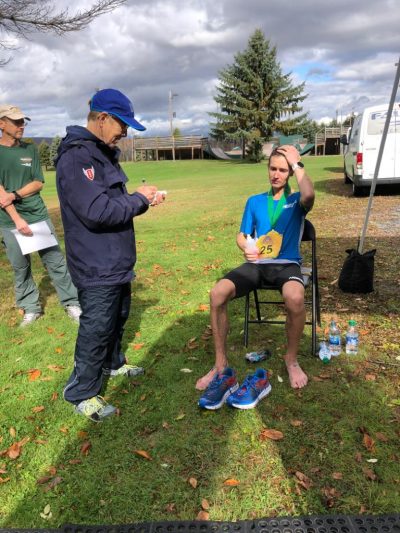
Good stuff Tyler, glad to see it come together.
Thank you!
This is awesome Tyler! Thanks for sharing! Have seen you post quite a bit on reddit /r/AdvancedRunning, but enjoyed reading this post here with photos and everything a lot more 🙂 Congrats on the win, CR, worlds standard, and negative split!
Loved the story, Tyler! Not knocking you or the course, but as a veteran of many Leadvilles and other races in the Rockies, I did have to chuckle at what you considered steep climbs and rough terrain… all at low altitude! 😂 And how little you hydrated. And Oreos!! But congrats on the terrific achievement!
[…] marathon or, as LetsRun.com forum posters like to note, a “jogging race”. [8] Recap here: https://strivetrips.org/blog/keep-showing-up/ [9] “Casa Chasqui” is a mix of Spanish and indigenous Andean Quechua which basically translates […]
Don’t know why I didn’t read this before, but that wasn’t David Kilgore, it was me. David shouldn’t have getting dropped at Mile 10 attached to his name:)
Haha wow good find and apologies for the mixup! I’m glad to have enjoyed some miles together 🙂